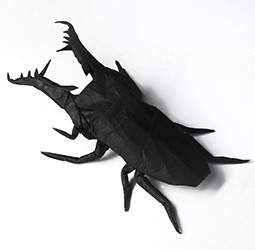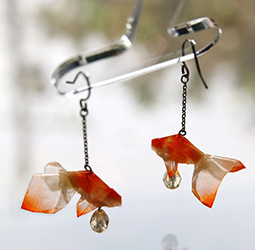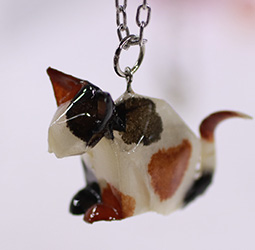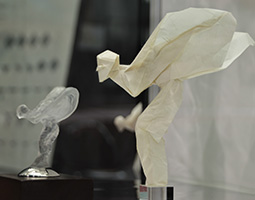
Arisawa Yuga making washi paper at the handmade washi studio Corsoyard 
The origami stag beetle created by Arisawa in his junior high school years 
Resin-coated origami goldfish earrings created by Arisawa 
Resin-coated origami cat necklace created by Arisawa 
Arisawa demonstrates his Spirit of Ecstasy origami creation at an exhibition of Rolls-Royce cars in Tokyo 
The Rolls-Royce Spirit of Ecstasy hood ornament fashioned in glass (left) and Arisawa’s origami version (right)
December 2021
Artist Creates Origami with Washi He Makes Himself

To freely create the works he visualizes, the young origami artist Arisawa Yuga became an artisan papermaker.

Arisawa Yuga was born in Hokkaido in 1997. He is an origami artist who has created a series of ambitious original works. These works are held in such high regard that he won a national contest organized by the Japan Origami Academic Society in 2018.
Arisawa first encountered origami in kindergarten. He learned how to fold from a TV show and showed his creations to everyone at school. Arisawa was so happy with the compliments he received from everyone that he started creating origami with great enthusiasm. In his later years at elementary school, he came in contact with the works of Kamiya Satoshi, a master of “super complex” origami, and started challenging himself to create his own unique works. In his first year of junior high school, he managed to complete an original stag beetle work all by himself.
Arisawa says, “I got a sense of achievement just from folding the six legs of a bug from a single sheet of paper. I noticed that I could make original origami too, which became a major turning point for me.”

Spurred on by the completion of the stag beetle, he pursued intricate and complex folding techniques, gradually producing his own original origami works. Recently he has used computer software to bring his designs close to perfection.
Arisawa is very particular about folding from a single sheet of paper without any cuts. However, as the folding processes become more complex, tears in the paper also become more frequent. Arisawa’s interest eventually moved beyond just origami to its raw material, the paper. In particular, he was drawn to the supple and sturdy washi (traditional Japanese paper), and during his high school years, he visited and walked round ten studios and factories in the four areas producing washi in Japan. Once he graduated from his high school in Hokkaido, he got a job at the handmade washi studio Corsoyard in Mino City, Gifu Prefecture, which is where one of Japan’s best-known papers, Mino washi, is produced.

Arisawa comments, “When you repeatedly fold hundreds of times or have parts comprising dozens of paper layers, you want paper that’s strong but also really thin. I thought it would be a joy to make my own washi, controlling the thickness and strength as I wish. So, I decided to become a papermaker.”
Just as he says, once he was freed from the restrictions of the paper, not only did the precision and expressive power of his origami go up, but he could freely come up with ideas for things he wanted to make.

Normally, the paper Arisawa makes goes to lighting fixtures manufacturers and paper lantern artisans, but he also makes washi products for sale to the general public, such as washi origami sets and origami earrings. Recently, he has been receiving more orders from companies for original origami that can be used for promotional purposes such as in advertising or as novelty gifts. In the autumn of 2019, for example, he received a request to create and demonstrate an origami version of the Spirit of Ecstasy*, the hood ornament on Rolls-Royce cars, for an exhibition of the cars in Tokyo. Arisawa says that he made it by folding handmade washi more than one hundred times to complete the work.


Arisawa explains, “In the same way that we inherit the trials and errors of our seniors in the origami world to be able to create new ways of folding, new types of washi are only possible because we inherit the tradition of washi-making. I can feel myself being part of that tradition. Right now, I’m writing an origami book that explains how to fold my original works, and I look forward to seeing new enthusiasts and creators being born from this.”
Arisawa is far from finished challenging himself as he folds new washi works and pursues his own unique world.
* The Spirit of Ecstasy is the official Rolls-Royce mascot and depicts a woman wearing a billowing dress. Also known as the Flying Lady.

